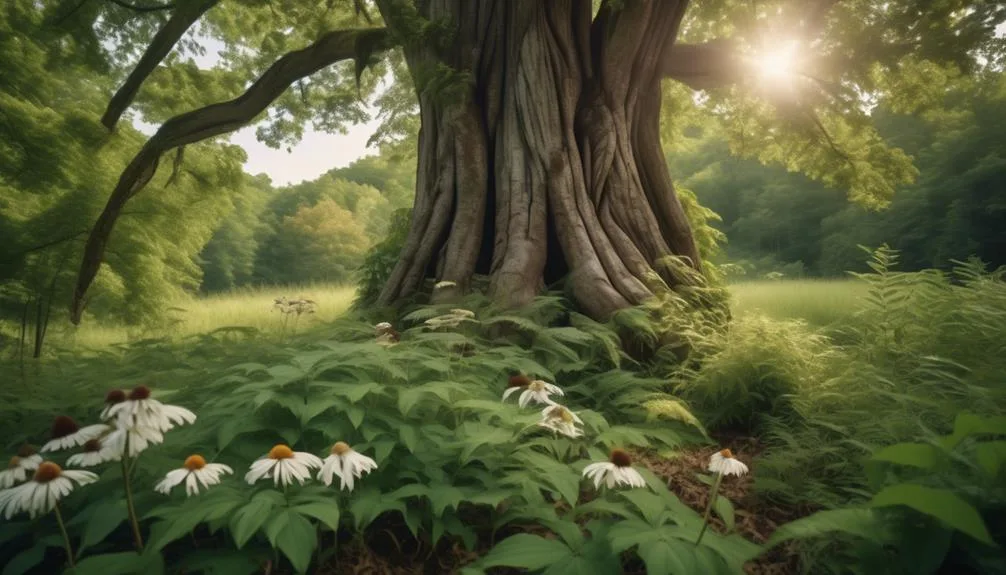Enhance your hickory tree's beauty and health with the perfect plant partners. Imagine a vibrant patch of purple coneflowers flourishing beneath your towering hickory, attracting pollinators.
From nitrogen-fixing legumes to shade-tolerant groundcovers, the options are endless.
Ready to discover the best companion plants for your hickory trees? Stay tuned to learn how to create a harmonious garden that takes your hickory trees to new heights.
Sun-Loving Perennials
When selecting sun-loving perennials as companion plants for your hickory tree, consider their growth habits and bloom times to create a harmonious and visually appealing landscape.
Sun-loving perennials that thrive in well-drained, slightly acidic soil are ideal companions for hickory trees. Plants like lavender, black-eyed Susans, and Russian sage are excellent choices due to their adaptability to various soil types and their ability to withstand the dappled sunlight that filters through the hickory tree's canopy.
When planting these sun-loving perennials, ensure that the soil is loosened to a depth of at least 12 inches to promote root growth and water penetration. It's also crucial to space the plants strategically to allow for airflow and prevent overcrowding, which can lead to disease.
Shade-Tolerant Groundcovers
Consider planting shade-tolerant groundcovers around your hickory tree to create a lush and low-maintenance landscape under the canopy.
Moisture retaining mulch, erosion-preventing ferns offer a practical solution to keep the soil moist and prevent erosion while adding a touch of greenery.
Fruiting vines, such as wild strawberries or creeping raspberry, can also thrive in the shade, providing both visual interest and a tasty harvest.
Low maintenance mosses, like Irish or Scotch moss, are excellent choices for filling in the gaps between other plants, adding a velvety carpet-like texture.
These groundcovers not only enhance the beauty of the area under your hickory tree but also help to retain moisture, prevent erosion, and reduce the need for frequent maintenance, making them a practical and visually appealing choice.
Nitrogen-Fixing Legumes
Nitrogen-fixing legumes, such as clover and vetch, play a crucial role in enhancing the soil fertility around your hickory tree, promoting healthier growth and overall ecosystem balance. These legumes have a unique ability to convert atmospheric nitrogen into a form that can be utilized by plants, enriching the soil with this essential nutrient.
By planting nitrogen-fixing legumes as companions to your hickory tree, you can naturally improve soil health and provide a sustainable source of nitrogen for your tree and other surrounding plants. Incorporating these legumes into your garden not only supports the health of your hickory tree but also benefits the entire ecosystem.
Additionally, using legumes in crop rotation can contribute to the long-term sustainability of your garden by reducing the need for synthetic fertilizers and promoting a more balanced and resilient environment.
Pest-Repelling Herbs
To naturally deter pests and protect your hickory tree, consider incorporating pest-repelling herbs as companions in your garden.
Natural insect deterrents like basil, mint, and lavender not only add fragrance and beauty to your garden but also help in keeping pests away from your hickory tree.
Basil, for example, can repel mosquitoes, flies, and aphids, while mint is effective against ants, aphids, and beetles.
Lavender not only repels moths but also attracts beneficial insects like bees and butterflies, creating a balanced ecosystem around your hickory tree.
These herbs can be beneficial plant pairings for your hickory tree, promoting its health and growth while naturally warding off common pests.
Pollinator-Attracting Flowers
Incorporating pest-repelling herbs like basil, mint, and lavender not only protects your hickory tree but also creates a vibrant environment that can attract pollinator-attracting flowers, fostering a balanced and thriving ecosystem.
To enhance your garden design and encourage butterfly-friendly blooms, consider planting native wildflowers around your hickory tree. Native wildflowers not only add beauty but also offer significant landscaping benefits by attracting bees, butterflies, and other pollinators.
Selecting a variety of native wildflowers such as coneflowers, black-eyed Susans, and milkweed can create a diverse and colorful landscape, providing nectar and pollen for pollinators throughout the growing season.
These vibrant blooms not only enhance the aesthetic appeal of your garden but also play a crucial role in supporting the local ecosystem.
Conclusion
Incorporating a variety of compatible plants around hickory trees creates a thriving ecosystem that benefits the tree and its surroundings. Whether it's nitrogen-fixing legumes, pest-repelling herbs, or pollinator-attracting flowers, thoughtful plant selection enhances both the health and beauty of the hickory tree environment.
How will you enrich your hickory tree's surroundings?
Happy planting!
Mark Hoffman is a dedicated arborist and tree care specialist with over a decade of experience. His love for trees began when he visited Yosemite National Park as a teenager and was awestruck by the giant sequoias. Mark pursued his passion by studying forestry at Michigan Technological University, where he earned a Bachelor of Science degree.
Since then, he has worked tirelessly in the field of arboriculture, helping to preserve and protect trees in his community. His expertise and dedication have made him a respected leader in the industry and a valuable resource for anyone seeking advice on tree care.
